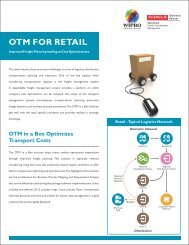Cashier downtime in retail vsf 07 12 11 final web
Cashier downtime in retail vsf 07 12 11 final web
Cashier downtime in retail vsf 07 12 11 final web
You also want an ePaper? Increase the reach of your titles
YUMPU automatically turns print PDFs into web optimized ePapers that Google loves.
Metrics to Capture <strong>Cashier</strong><br />
Downtime & Productivity<br />
Metrics Formula<br />
Total Hours worked<br />
by the <strong>Cashier</strong> for a<br />
day<br />
<strong>Cashier</strong> Downtime<br />
for a day*<br />
<strong>Cashier</strong> Productivity<br />
percentage for a day<br />
∑ (<strong>Cashier</strong> Signoff - <strong>Cashier</strong> Log<strong>in</strong>) [<strong>Cashier</strong> Log<strong>in</strong><br />
on a register, <strong>Cashier</strong> Sign off on that register] for all<br />
<strong>in</strong>tervals of a day for all registers logged <strong>in</strong> by the cashier<br />
∑<br />
(<strong>Cashier</strong> Auto Logoff - <strong>Cashier</strong> Log<strong>in</strong>)<br />
for all <strong>in</strong>tervals of a day for all registers logged <strong>in</strong> by the cashier<br />
+ ∑ { [Next Transaction Start Time – Previous<br />
Transaction End Time] if it is > X} [<strong>Cashier</strong> Log<strong>in</strong> on a<br />
register, <strong>Cashier</strong> Logoff on that register] for all <strong>in</strong>tervals of a<br />
day for all registers logged <strong>in</strong> by the cashier<br />
Where X is a threshold def<strong>in</strong>ed by the bus<strong>in</strong>ess<br />
users<br />
{ 100 – [(<strong>Cashier</strong> Downtime for a day*) + (<strong>Cashier</strong><br />
Log<strong>in</strong> on a Register Time – <strong>Cashier</strong> Clock Punch-<strong>in</strong><br />
time) + (<strong>Cashier</strong> Clock Punch-out Time – <strong>Cashier</strong><br />
Logoff on a Register Time) / ∑ [ (<strong>Cashier</strong> Scheduled<br />
End Time - <strong>Cashier</strong> Scheduled Start Time) -<br />
(<strong>Cashier</strong> Scheduled Meal Time + <strong>Cashier</strong><br />
Scheduled Break Time) ] [<strong>Cashier</strong> Clock Punch In,<br />
<strong>Cashier</strong> Clock Punch Out] *100] }<br />
Examples to Illustrate<br />
<strong>Cashier</strong> Downtime &<br />
Productivity Metrics<br />
The metrics can be illustrated by the follow<strong>in</strong>g examples:<br />
Total Hours worked by the <strong>Cashier</strong> for a day<br />
= ∑ (10:30 AM – 8:30 AM) + (1:00 PM – 10:45 AM) +<br />
(3:30 PM – 1:30 PM) + (4:30 PM – 3:45 PM)<br />
= (<strong>12</strong>0 + 135 + <strong>12</strong>0 + 45) / 60<br />
= 7 hours<br />
<strong>Cashier</strong> Downtime for a day<br />
= (2:30 PM – 2:15 PM) + ∑ {[8:50 AM – 8:30 AM) + (9:20 AM – 9:00<br />
AM) + (10:45 AM – 10:10 AM) + (<strong>12</strong>:27 PM – <strong>11</strong>:51 AM) + (1:49 PM<br />
– 1:21 PM) + (3:30 PM – 3:06 PM) + (3:59 PM – 3:33 PM)] if it is<br />
> 20 m<strong>in</strong>utes}<br />
= {(15) + ∑ 20 + 20 + 25 + 36 + 28 + 24 + 26} / 60<br />
= 3.23 hours<br />
<strong>Cashier</strong> Productivity percentage for a day<br />
= {100 – [(194) + (8:45 AM – 8:15 AM) + (4:45 PM – 4:30 PM) /<br />
∑ [(4:45 PM – 8:15 AM) – (30 + 15 + 15)] *100]}<br />
= {100 – [194 + 30 + 15 / ∑ [510 – (30 + 15 + 15)] *100]}<br />
= {100 – [239 / 450] *100]}<br />
= {100 – [239 / 450] *100]}<br />
= 46.88 %<br />
Conclusion<br />
There are no def<strong>in</strong>ite studies which give the cost of cashier <strong>downtime</strong> as a<br />
percentage of total store operational cost, however keep<strong>in</strong>g the service<br />
level high by load<strong>in</strong>g the cost on to the cashiers is a common phenomenon<br />
among discount, mass merchandiz<strong>in</strong>g, departmental and grocery <strong>retail</strong>ers.<br />
Def<strong>in</strong><strong>in</strong>g metrics for comput<strong>in</strong>g cashier <strong>downtime</strong> will enable awareness of<br />
productivity and guest wait opportunities i.e. service level of 1+0, 1+1,<br />
1+2 etc.<br />
This solution will enable immediate resolution to service level<br />
performance and guest wait issues and the scores will motivate store team<br />
members to improve their performance as well get tra<strong>in</strong><strong>in</strong>g to enhance<br />
their productivity.<br />
Reduction of cashier <strong>downtime</strong> will also lead to improvement <strong>in</strong> cashier<br />
productivity and could be used for generat<strong>in</strong>g progress reports,<br />
recognition awards and mentor<strong>in</strong>g store team members.<br />
However zero cashier <strong>downtime</strong> is also not good as it implies that the<br />
cashiers are busy all the time and there are guests wait<strong>in</strong>g <strong>in</strong> l<strong>in</strong>e to be<br />
serviced. So a balance has to be achieved to br<strong>in</strong>g the <strong>downtime</strong> to a level<br />
where it doesn’t affect the service levels.<br />
Improv<strong>in</strong>g performance and guest shopp<strong>in</strong>g experience is a core function<br />
of deliver<strong>in</strong>g exceptional guest service and reduc<strong>in</strong>g operational expenses<br />
and cashier <strong>downtime</strong> reduction can lead to achievement of both.<br />
<strong>07</strong>

















